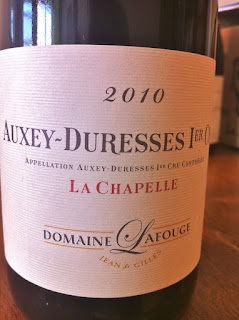Simple Things and Complex Things
It was a holiday evening and I was at my good friend Peter's house for dinner. You already know that he is one of very finest wine writers and critics, and that he is the author of ChampagneGuide.net, and that he recently published a long-awaited Sherry book. But did you know that he is a wonderful cook?
Peter can cook anything but prefers to cook in the Japanese style. And on this Christmas eve, I hung around his kitchen while he prepared dinner. We talked about how his book is selling, how my work is going, about our plans for travel in the coming year, about how I miss my kids on the Christmas holidays, and all sorts of other things that good friends talk about. We drank Champagne. Good music wafted from the sound dock speakers.
He used Koshihikari rice from the Niigata Prefecture in Japan. This is thought by many to be the finest rice of Japan. Peter rinsed the rice many times, massaging it with his hands, until the water ran almost clear. Then he spread it evenly in the bowl and let it dry. Then he combined water with a dash of fish sauce, sesame oil, and sake, and soaked the rice for about a half hour. He placed quartered Shitake mushrooms and large whole scallops on top of the rice and cooked it over high heat for 15 minutes and then let the rice rest for another 20 minutes. The whole process took about two hours from start to finish. As the rice rested, the kitchen and the living room filled with this intensely savory and gloriously appetizing aroma.
Peter opened the Donabe, coarsely chopped the scallops with a wooden spoon, fluffed the rice a little, and served it in bowls topped with scallions and mitsuba, a Japanese herb. This was the very best rice I have ever eaten, without any question. One of the best foods I have ever eaten. I will not try to describe the flavors because I'm not good enough with language to do so.
Since watching this preparation and eating this rice, I've thought some about how simple things can be so complex. I can enjoy the rice at a Chinese restaurant, or the rice I cook at home, and it tastes good. It is nice to eat with whatever other food I'm eating. I do not need rice to be the finest rice Japan has to offer, prepared in the finest of Donabes by an expert hand in order to appreciate it. But I'm glad that I now know a little tiny bit about this - about what is possible to achieve with rice. It's not that I will now look down upon all other rice, it's about the fact that there exists a complex set of tools and techniques for growing and cooking rice, and being aware of this makes me a more educated person. We mostly think of rice as a simple thing, and that doesn't reduce the pleasure we take in it. There is an elevated form of rice too, and that is also pleasurable, I would say immensely so. These two things are not mutually exclusive.
The same is true with so many things that we eat and drink - think of roasting a chicken! There are a million variations, including the chicken itself, temperature, type of pan, and other issues. People who care about roasting chicken have opinions on all of these things. Roast chicken is a simple thing that is also quite complex, should you choose to approach it that way. And although a decently prepared roast chicken is always enjoyable, some are finer than others. I think that experiencing and trying to understand things in their most elevated forms allows us to better understand the pleasures (and flaws) of their more common versions.
I hope that in the coming year I learn more about the complexities that seemingly simple things have to offer. And I hope to spend more time in the company of great friends, enjoying these things together. I hope the same for you, and happy new year!




























































